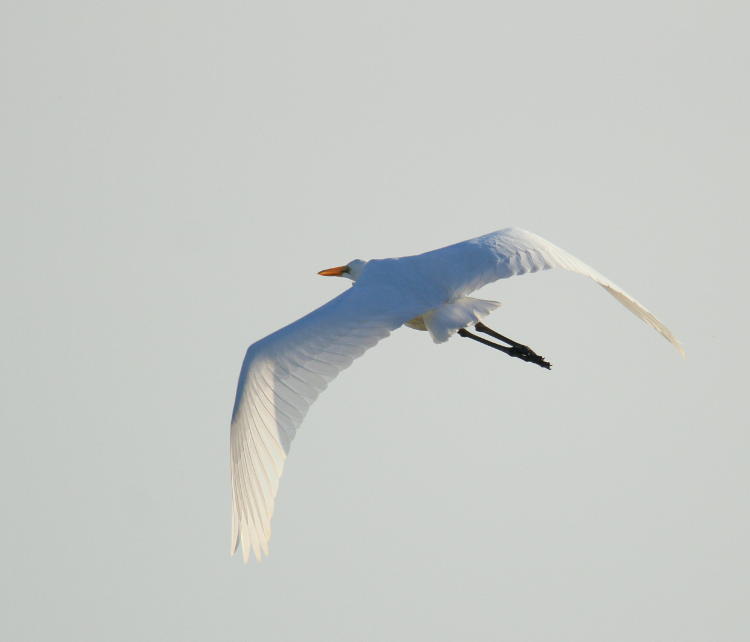
On a sunset outing to Jordan lake almost a week ago, we had clear skies – not ideal for sunset – except for some haze down on the horizon – not ideal for birds, which were pretty much the only thing that we saw. The majority of those were more distant, which put them down lower and thus against the haze, so most of the backgrounds for this post are going to be anywhere from pale grey to an anemic blue. But whatcha gonna do?
Above, the dead tree on the point at one of our two common shooting locales was heavily loaded with roosting black vultures (Coragyps atratus,) apparently exhausted from a long day of circling and looming. I’m guessing, anyway. Yes, this is aimed almost straight up, and yes, we were at times directly underneath, yet nothing untoward befell us – the vultures were slightly edgy about our presence, but not seriously. At times most of them would take to the air and circle widely for a bit, not because of anything apparent that we did, then some would return while others would find roosts a few hundred meters away. Not the kind of behavior we were looking for, so we largely ignored them.
In the distance, I tracked a bird passing low and straight beyond the causeway road to our left, and fired off a few frames to ensure that I had the identification correct.
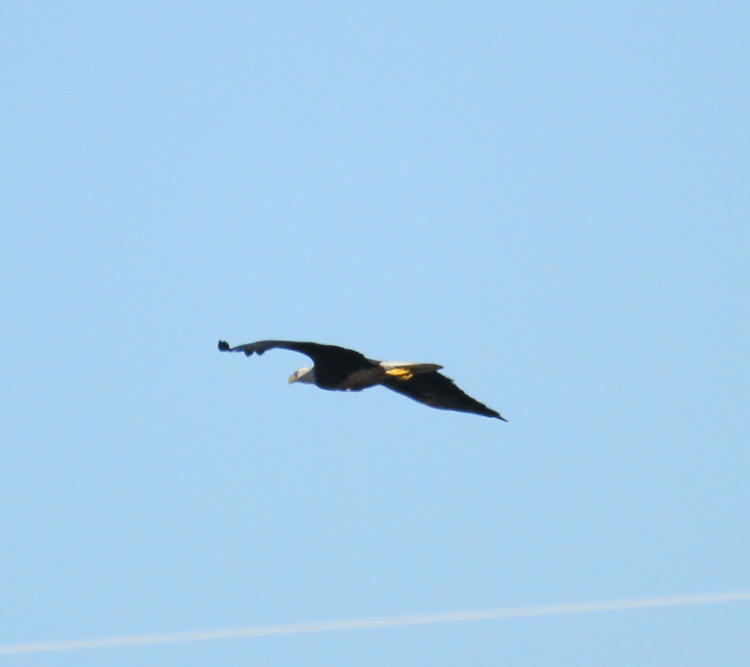
That is indeed a bald eagle (Haliaeetus leucocephalus,) an adult, and we watched to see if it would turn or circle and start hunting, but like many of the times we’ve seen them at that location, it seemed intent on going someplace and never wavered from a straight line path.
 Curiously, less than a minute later it was followed by another bird, this one marked differently, who banked back and forth briefly in the middle of its path before continuing on in the same direction that the previous had been heading.
Curiously, less than a minute later it was followed by another bird, this one marked differently, who banked back and forth briefly in the middle of its path before continuing on in the same direction that the previous had been heading.
This is cropped tightly from a much larger frame, cutting out the power lines that were visible (and found in the adult picture above it,) but this is a juvenile bald, likely second year from the mottled coloration and the lack of an eye stripe in a paler face, which develops in the third year. And just so you know, the first year they’re largely unmarked brown, while fourth year they get the adult coloration of white head and tail that we’re all familiar with. While it seemed to be following the adult (so I’m supposing a parent,) it was with enough distance that it wasn’t obviously following it. Or it may simply have been a coincidence, traffic on the eagle highway. But can you see the joker face on the lower wing? I see it plainly, but The Girlfriend couldn’t, even when I pointed it out. Must be something Freudian.
[Whether that’s on my part or hers, I’m not saying…]
There were osprey present, but they were being only semi-cooperative.
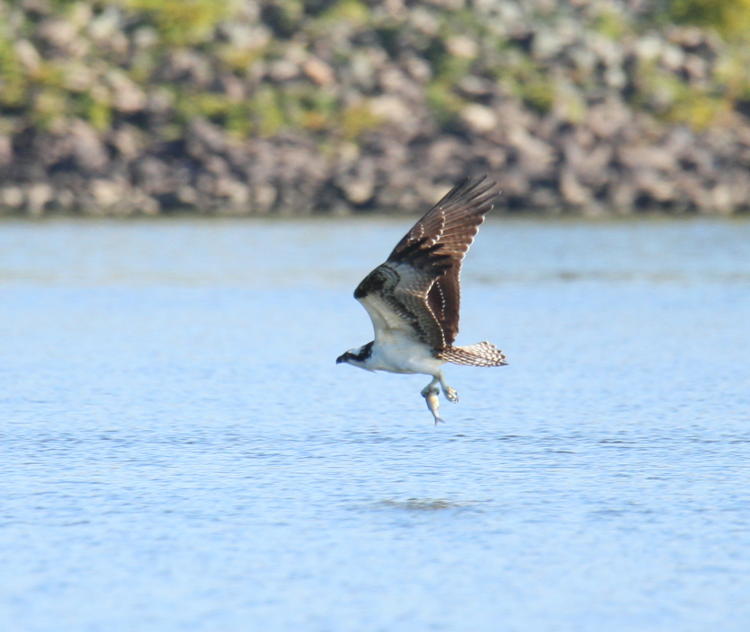
Generally, when they chose to dive after fish, it was at a great distance where detail wasn’t going to be forthcoming, and I only snapped a few frames of this one as it lifted off after a capture. Let’s back off a bit to see the full frame.
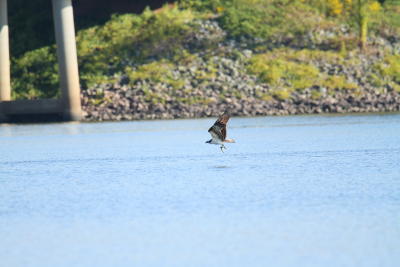 This is the full frame, and a bit smaller than it appeared in the viewfinder, but enough of an impression anyway, and this was with the long lens at 600mm. There’s no easy way to gauge distance over open water, but the background was a measured (Google Earth can be handy) 0.6 kilometers in the distance, so I’m guesstimating that the osprey was between 200 and 300 meters away – not what we really wanted to see.
This is the full frame, and a bit smaller than it appeared in the viewfinder, but enough of an impression anyway, and this was with the long lens at 600mm. There’s no easy way to gauge distance over open water, but the background was a measured (Google Earth can be handy) 0.6 kilometers in the distance, so I’m guesstimating that the osprey was between 200 and 300 meters away – not what we really wanted to see.
And while I’m filling up space alongside the photo before we go to another full-column-width image, I’ll point out that I’m still having problems with keeping the camera level, but at least I know now (from paying some attention at times) that it seems to stem largely from how the camera sits in my hand; it feels level, but is actually at a slight angle, and I may try to trick out a small grip addition that helps intuitively bring it back to proper orientation.
Yet the ospreys weren’t entirely uncooperative…
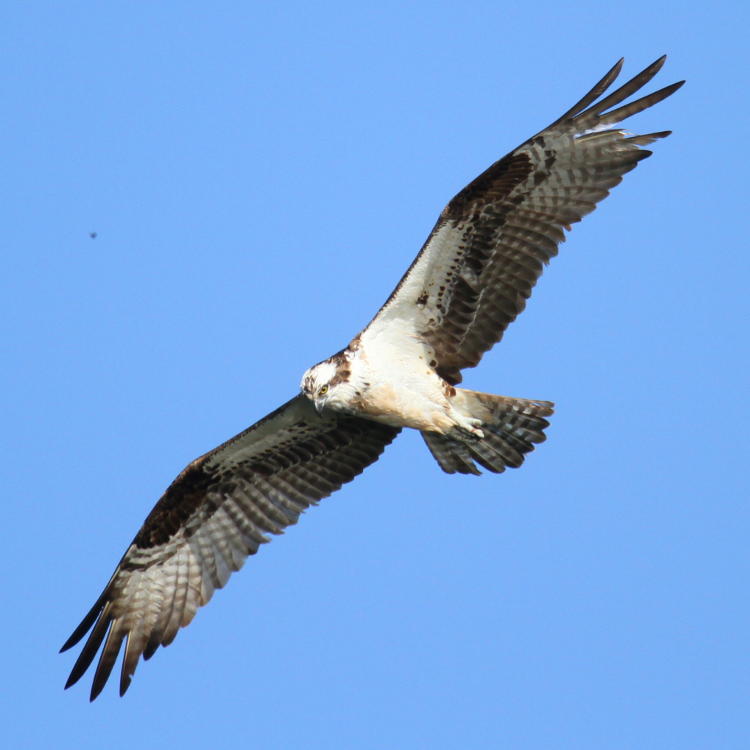
One came in close and wheeled around the small bay to our left a few times, and since the sun was dropping lower in the sky, it provided great light as the osprey banked away from us, which is when I start cranking off the frames. You can even tell that it’s intent on the water, but it never found anything to dive on when it was close and well-lit like this – bugger. But you take what comes, unless you know of some way to coax fish close to the surface at the ideal position to compose the osprey pics. If so, let me know; you owe me, after all the content I’ve provided.
As for the speck in the frame, I’m guessing an insect, but fore or aft of the bird I’m not sure. Don’t ask for identification.
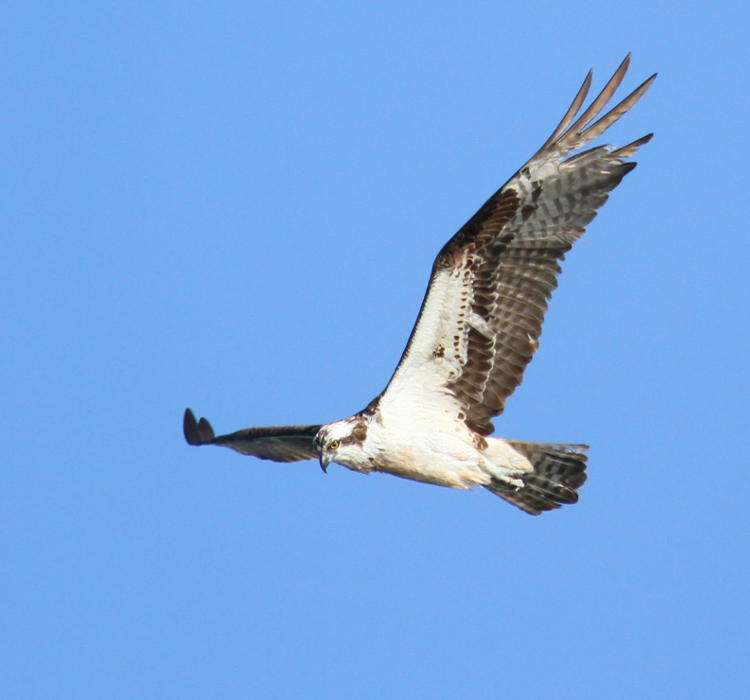
Nice light, nice distance, autofocus largely behaving itself – but no real action. No, the same bird (I’m pretty certain) ended up cruising away directly into the sun before it found itself a fish to capture, eliminating everything that would have made for good images. I mean, see if I send it a christmas card this year…
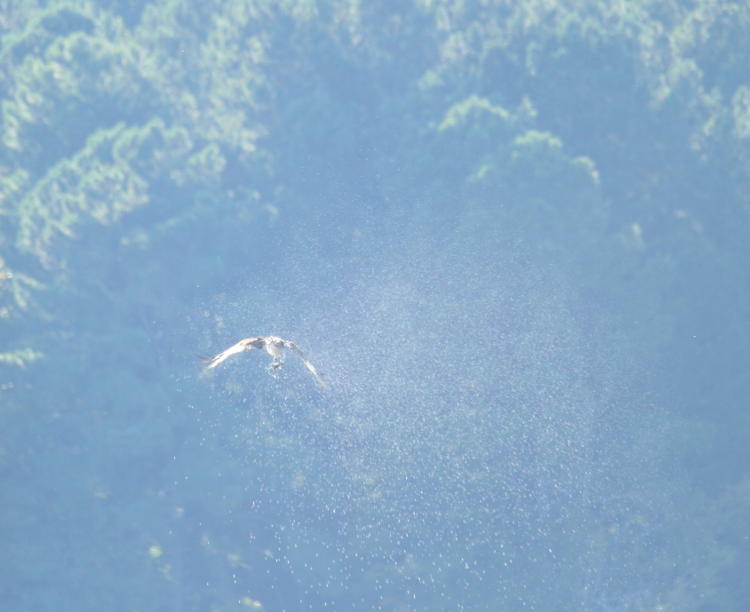
This demonstrates the radical difference in conditions when turning roughly 180° away, but also a dependable habit: osprey will climb out a few meters above that water after a dive, then shake vigorously to disperse most of the retained water, often dropping a meter or so as they do. The backlighting served a useful purpose here in highlighting how much water this can be.
A little later on, I tracked another bird well off, at least twice the distance of the first osprey up there, unidentifiable until I got the long lens on it.

Yep, another bald eagle, and soon after spotting it, it did a wonderful dive after a fish.
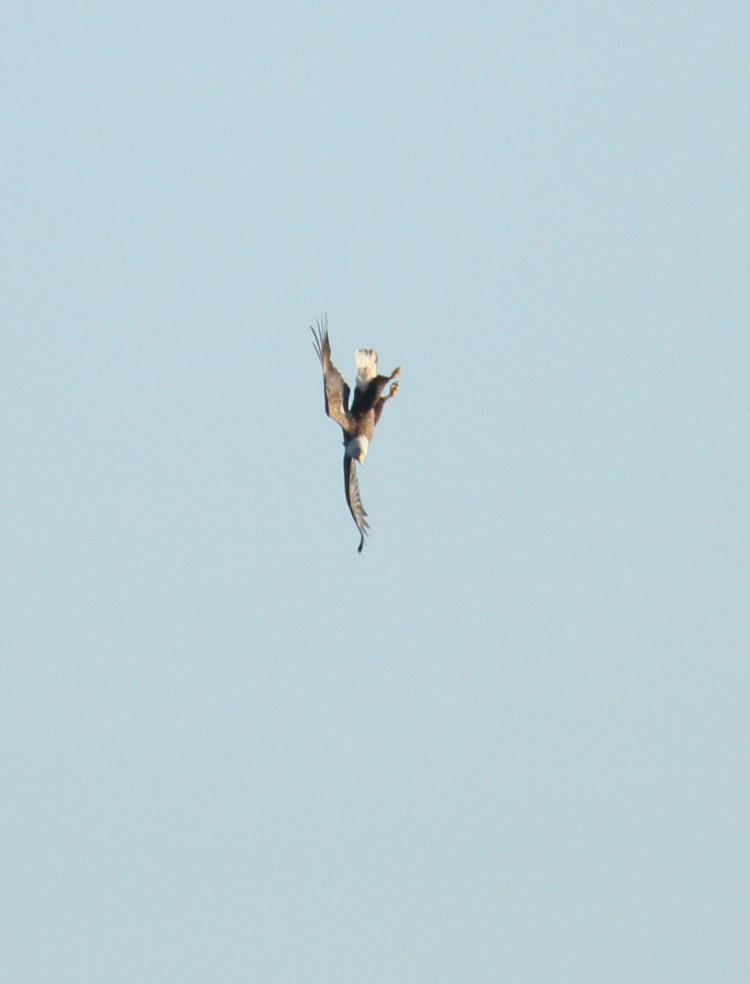
The vertical portion didn’t last long, but I was happy to capture it as it occurred; you can just hear that WWII diving fighter sound effect, can’t you? In fact, why imagine it?
[Yeah, I really did spend about 20 minutes searching for that, downloading and converting it, just for a throwaway part of the post.]
Naturally enough, the autofocus started doing its random tracking thing as the bird crossed the horizon treeline, even when the camera is supposedly set to avoid doing that, one of the advanced custom functions on the 7D; a lot of this might be due to the extreme difficulty in maintaining the eagle in the AF ‘crosshairs’ of the viewfinder, handheld with a heavy lens on a moving and tiny target, but it still irks me. So I did not regain sharp focus until the eagle had already risen with its catch, but it did allow me (us, really – Buggato had by this time acquired the target and was shooting his own images) to watch a curious behavior.
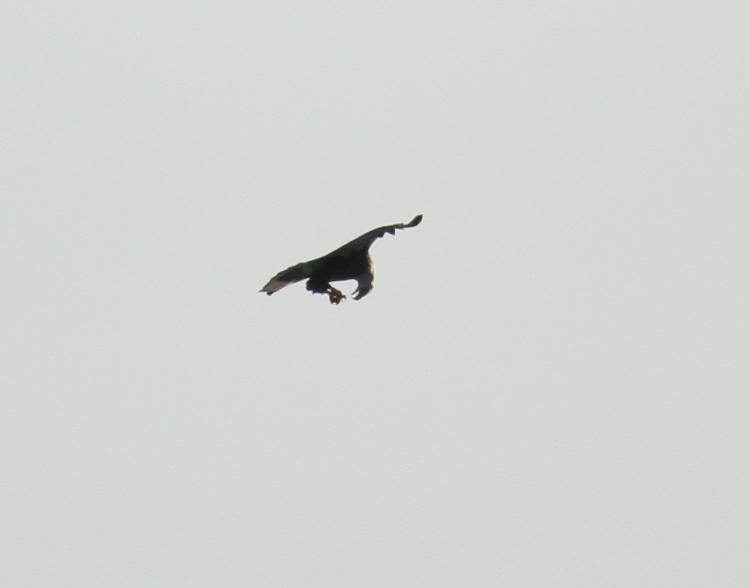
The eagle bent down several times in mid-flight to worry at the fish clutched in its talons, and I surmised that it was trying to ensure that the fish was dead and not going to wrest itself free. Which had me wondering a little, because eagle talons should be more than adequate for that job, so was this somehow a dangerous fish that could bite back or something? I’ve seen hawks in such difficulties with snakes, but this didn’t appear to be a snake and was way the hell out over open water where I wouldn’t expect to see one.
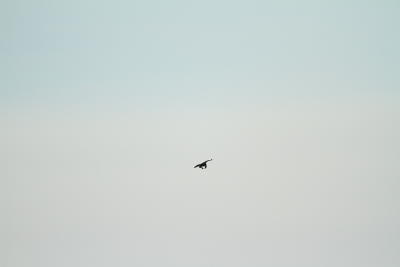 But while we’re here, we’ll take a look at the full-frame again, to give an idea of distance and difficulty in keeping the subject centered within the focus area; you can compare this with the full-frame image of the osprey from earlier in the post. This also shows the difficulty in discerning what exactly the eagle was doing, which wasn’t actually revealed until I was back home and could look at the frames at full resolution – you’re not quite seeing full resolution in most of these images, but close enough for our purposes.
But while we’re here, we’ll take a look at the full-frame again, to give an idea of distance and difficulty in keeping the subject centered within the focus area; you can compare this with the full-frame image of the osprey from earlier in the post. This also shows the difficulty in discerning what exactly the eagle was doing, which wasn’t actually revealed until I was back home and could look at the frames at full resolution – you’re not quite seeing full resolution in most of these images, but close enough for our purposes.
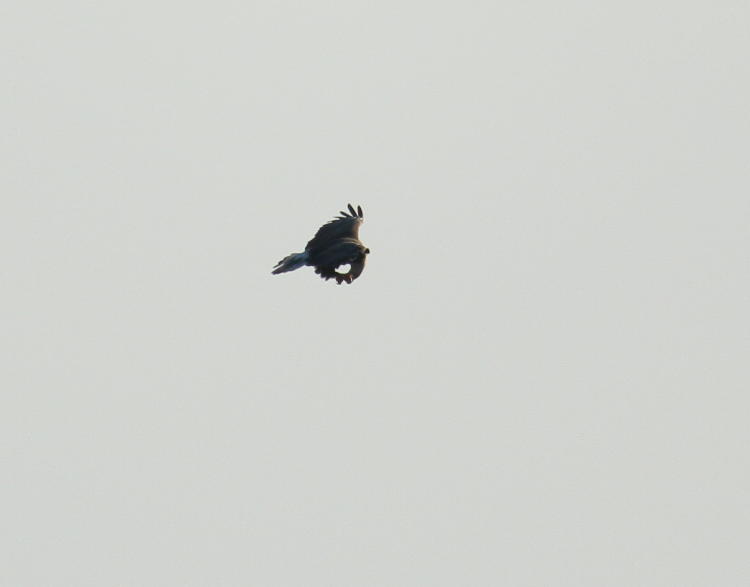
Because the eagle was actually eating the fish in mid-flight, something that I’ve never witnessed from a raptor, and not even waterfowl, except for very small meals.
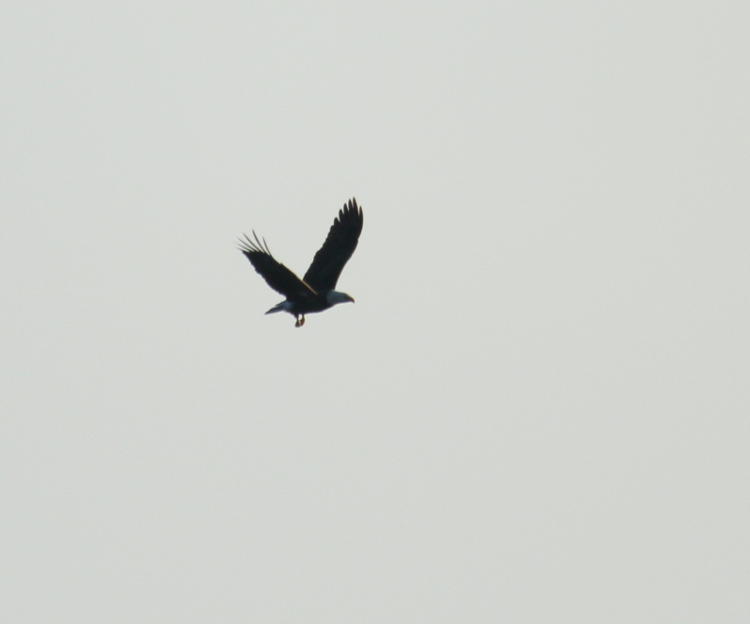
In moments, it was gone, and the eagle continued on its merry way as if seeking a perch to consume a meal that was already polished off on the way home. It’s like when your dad gets home with fast food and you ask, “Where are the fries?” and he replies, “Damn, they must have forgotten them…” In fact, this may help explain why the juvenile was following distantly behind the adult earlier in the day, trying to catch the parent in the act. Kids aren’t as stupid as we think sometimes.
I’ll close with a couple of great egret (Ardea alba) photos – really, this might be the year of the great egret, because I’ve shot a lot of them. I might have to check and see if I’ve gotten one every month so far.
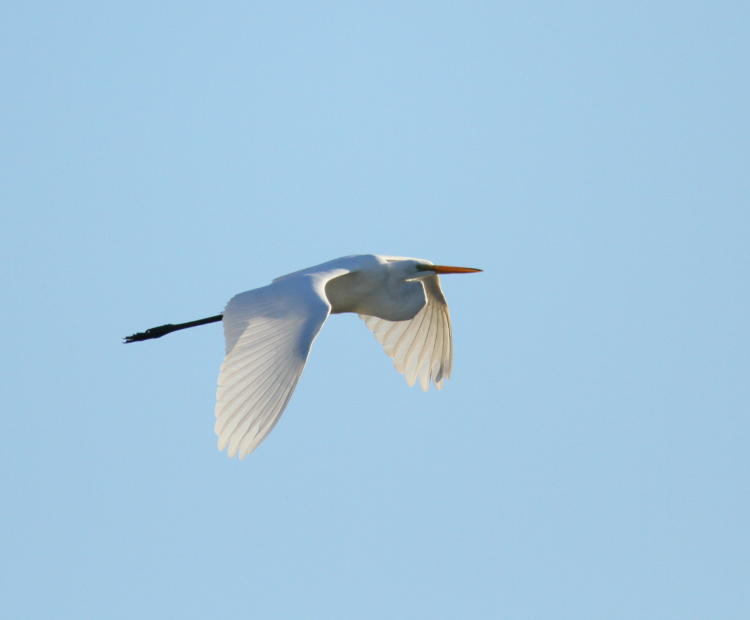
One flew in as we were standing there, circled around the boat dock area as if undecided on the perfect perch, then flew back out again in roughly the direction that it had come. I’m guessing it was looking for its credit card.
The differences in the sky are evident in these two frames, and the sun was closer to behind the egret than in an ideal position, but this led to some nice sidelighting and glow from the wing feathers, so it works, and the AF locked on nicely, so these are sharp enough to make into large prints. Not a bad end to the day, even when sunset didn’t pan out.
